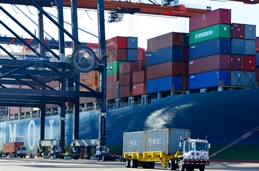
On January 6, the Port of Jacksonville (JAXPORT) in Jacksonville, Florida, welcomed the 8,100 teu MOL Competence to its TraPac Container Terminal at Dames Point. The ship, which traveled from Southeast Asia through the Suez Canal to other US East Coast ports before arriving at TraPac, not only was the largest vessel to ever call on Jacksonville’s seaport, but was the first of others to come.
JAXPORT executive vice president Roy Schleicher sees this developing trend toward larger vessels as a game changer for the port, which already experiences balanced import/export trade.
“These larger vessels should add volume to the port,” he says.
JAXPORT offers direct trade with Asian ports through both the Panama and Suez Canals and currently 12 of the 18 global ocean carriers servicing the Asia-US trade lane offer service at the port. In the last several years, the port has seen increased rotations from steamship lines such as those of the G6 Alliance; MOL and Evergreen, and China Shipping and UASC via CMA-CGM’s Pacific Express 3 (PEX3). Consequently, during the fiscal year ending Sept. 30, 2014, JAXPORT achieved 20% growth in Asian container shipments over fiscal year 2013, moving 272,524 teus compared to 226,938 last year. The Asian container trade is the fastest growing segment of JAXPORT’s container cargo business, accounting for nearly 30% in 2014, up from 24% the previous fiscal year.
Today, JAXPORT is ranked as the ninth largest container export port in the United States and the largest container port complex by overall volume in Florida.
Schleicher emphasizes that Suez Canal services bring volumes of goods still manufactured in China today in addition to that which is produced in new centres throughout Southeast Asia, Indonesia and India.
“The Suez Canal is natural fit for ships carrying those products to the United States via the US East Coast,” he says.
Schleicher also anticipates that JAXPORT will experience a positive impact from the expanded Panama Canal once it opens in 2016, although he does not anticipate a landslide of new business.
“West Coast ports and the railroads there aren’t going to wave white flag and let the cargo be taken out of West Coast,” he remarks. “They will fight to keep as much cargo as they can.”
But to facilitate the larger ships on both the Suez and Panama Canal trade lanes, JAXPORT has two major harbour improvement projects currently underway: the scheduled deepening in 2016 of its shipping channel to 47 feet so that the largest container ships can have unobstructed access to the port’s terminals; construction of an on-dock rail facility; berth and rail upgrades, and the purchase of several 100-gauge container cranes.
Six berths are being rebuilt at Blount Island Marine Terminal. Completion is expected this year.
“Not only are we preparing the docks at Blount Island to accept 100-gauge cranes, in October we signed a US$37.6 million contract with ZPMC to purchase three new super post-Panamax cranes for the terminal,” says Schleicher. “They will be able to reach across vessels 22 containers wide.”
Four berths are scheduled to be rehabilitated at the Talleyrand Marine Terminal with completion anticipated in 2016.
Other major pluses to the port include service by three US Interstate Highways (I-10, I-95 and I-75); 36 daily train departures via three railroads (CSX, Norfolk Southern, and Florida East Coast Railway); and increasing numbers of distribution centres in the area. Over the past seven or eight years, JAXPORT especially has experienced increased warehouse activity in the reefer sector largely because of cold chain imports and exports to Asia via Jacksonville.
“One of our big commodities is the refrigerated business,” Schleicher says. “Citrus and poultry are shipped worldwide, especially to Asia. Likewise, Jacksonville is both a big exporter and importer of seafood.”
Today, Sea Best Foods, which is the product line of Jacksonville-based Beaver Street Fisheries, is the largest importer, exporter and distributor of fish and seafood in North America. “The more product that can move through Panama Canal, the more need for increased reefer capacity – not just in containers but also in the warehouses,” he says.
In addition, an intermodal container transfer facility (ICTF) is currently being built to better facilitate cargo from Northeast Florida. “Our plan is to have it built and operational by the end of 2015,” says Schleicher. “This way when the larger ships are coming into our port, the ICTF will allow for easy access right to the ramp. Shippers will have the ability to run the containers directly out without going across any roads. “
This gives importers and exports the opportunity to move heavy boxes like poultry. In addition, importers and exporters will have the ability to move cargo quicker and more efficiently.
There is also a study underway to reroute trains out of Jacksonville to allow for faster transit to the Midwest markets.
“We currently have a 45-hour train to Chicago, but we are talking about even improving that,” Schleicher adds.
By Karen E Thuermer
Correspondent | Washington




